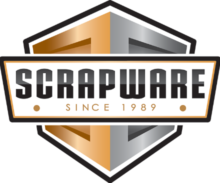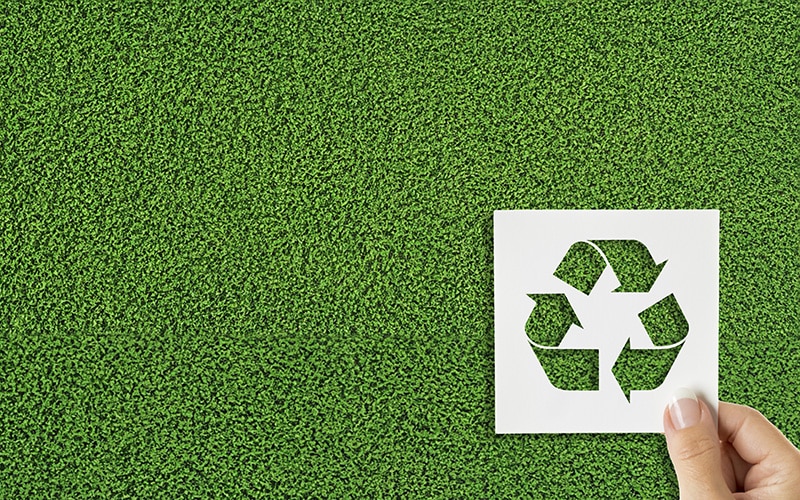Football season reignites debates about artificial turf. Whether slippery, hard turf contributes to athlete injuries isn’t the only controversy, however.
With the increasing focus on sustainability, more people are weighing the environmental impact of artificial turf by evaluating the challenges and opportunities of its recyclability.
Artificial turf pros and cons
Artificial turf, astro turf, and artificial grass are just some of the names used to describe the synthetic blades used to replace real grass at sports fields, residential lawns, putting greens, and other places where it might be difficult or expensive to maintain a lawn of natural grass. The artificial turf is clearly easier to maintain than a grass lawn because it does not need to be watered, mowed, or fertilized. It does not require pesticides, and it is more durable than natural grass. Sports stadiums that are fully or partially covered often use artificial turf, as they typically lack good conditions to grow grass.
The first artificial turf installation was in 1966, when it was installed in the year-old Houston Astrodome. The first-generation system of shortpile fibers did not include any infill, which is the sand or rubber now embedded in the grass “carpet.” Compared to the earlier systems, modern artificial turf more closely resembles grass in appearance and is also considered safer for athletic competition. It is still not widely considered equal to grass. Sports clubs, leagues, unions, and individual athletes have frequently spoken out against it for safety reasons, saying it leads to greater injuries to athletes. Others express concern about the use of toxic chemicals in its manufacturing process.
A new, bigger concern about astro turf, however, is what happens to it at the end of its life. The focus on sustainability has raised concerns about the volume of plastic astro turf components filling up landfills and efforts to increase its recyclability.
Artificial turf recycling challenges
Since artificial turf is made up largely of plastic components, many people assume it would not be hard to recycle. It is not the materials, however, but the complex construction of artificial turf that makes it challenging and costly to recycle.
An artificial turf installation is made up of numerous components. It includes a turf “carpet,” seams, infill, and sometimes pads for drainage and impact. The artificial blades of grass are typically made of plastic fibers, like polyethylene, polypropylene, and nylon. The backing which holds the grass blades in place is also made up of plastic materials. A liquid coating is applied as a secondary backing, securing the grass blades and providing durability. This coating is usually urethane, the most common material used in American-made artificial turf.
Seaming materials, which are used to join sections of turf together, are typically made of plastic like polyethylene and polypropylene. Adhesives are used to secure the seams, and sewing thread made of polyester or nylon may also be used.
Infill materials are used to add weight to the artificial turf and provide cushioning. Common turf infill materials include crumb rubber made from recycled tires, silica sand, and thermoplastics like thermoplastic elastomer (TPE) and thermoplastic olefin (TPO). Organic infill materials, such as coconut fibers and cork, are also becoming more popular.
Finally, pads for drainage and impact may be used to provide additional support and cushioning. Foam pads made of polyurethane, ethylene-vinyl acetate (EVA), or other foam materials may be used, as well as plastic drainage mats made of polyethylene or other plastics.
It is very challenging to separate and recycle each of these turf components separately, especially considering that the turf materials may be fused together with special adhesives. Another challenge in recycling used artificial grass from sports fields and lawns is the fact that after it is removed, it contains many different organic materials such as rocks, leaves, and dirt, making separation even more difficult.
Recycle and reuse efforts for artificial turf
In response to consumer demand for sustainable products, more companies are pursuing efforts to keep artificial turf out of the waste stream. As a result, there have been several advances in technology that simplify the process of recycling synthetic turf, and there are now several companies in the industry dedicated to turf recycling.
These companies have created systems that make it possible to recycle the components of artificial grass as efficiently as possible. During the recycling process, the landscaping materials are separated, processed, and recycled in the most efficient manner. The recycled materials are then converted into raw materials, which are used to create new products. For instance, once the plastics are separated from the artificial turf, they may go through a process known as “re-pelletizing.” During this process, the plastics in the artificial turf are cut, melted, and then turned into pellets, which are then used to create a variety of extruded plastic materials.
Last year, TenCate Grass, a Netherlands artificial turf manufacturer, announced it was launching a U.S. program to recycle end-of-life artificial grass. In this effort TenCate joined forces with the plastics recycling company Cyclyx and ExxonMobil, using that company’s Exxtend technology. Exxtend is ExxonMobil’s proprietary technology that breaks down plastics to the molecular level. This technology allows the creation of new virgin-quality plastic that can be put back into the supply chain.
The TenCate press release stated that the goal of the project is to help solve how to efficiently and effectively recycle synthetic turf into a feedstock that can be used to create new turf and other valuable products. “At TenCate, we are committed to leading the industry and moving sustainability forward in a meaningful way,” said Joe Fields, president and CEO of TenCate Grass Americas on their website. “We understand the issue of end-of-life synthetic turf, and we have taken it upon ourselves to find a true solution for the entire industry. Our goal is to keep turf out of landfills and put it back to use.”
The program will process 50 aged turf fields from high schools and college campuses across California. The end-of-life turf will be shipped to a Southern California facility where it will be shredded. The shredded turf will then be delivered from California to Texas, where Cyclyx International, will further reprocess it before sending it to ExxonMobil’s Baytown, Texas, advanced recycling facility. With ExxonMobil’s Exxtend technology, the end-of-life turf will be broken down into raw materials that can be used to make new products that are no different in quality and performance than those made from virgin raw materials. Some companies will extend the life of used artificial turf and keep it out of landfills by selling it to a new user. California-based Artificial Grass Recyclers is a company that will remove turf from locations and then resell it. According to their website, often the used turf is from a sports facility that was upgrading its surface. While it is not the same as recycling turf, it does extend its life and keeps it out of the waste stream.
About ScrapWare Corporation: Since 1989, Rockville, Maryland-based ScrapWare Corporation has been the software of choice for the recycling industry. Its ease of installation and simplicity saves users time and money while helping them achieve compliance and maintain accurate business insights. With state-of-the-art functionality that‘s tailored to each organization’s unique requirements, ScrapWare is an advanced dynamic software solution that alleviates the most pressing recycling industry worries. For more information, please call (301) 517-8500 or visit https://www.scrapware.com/.

